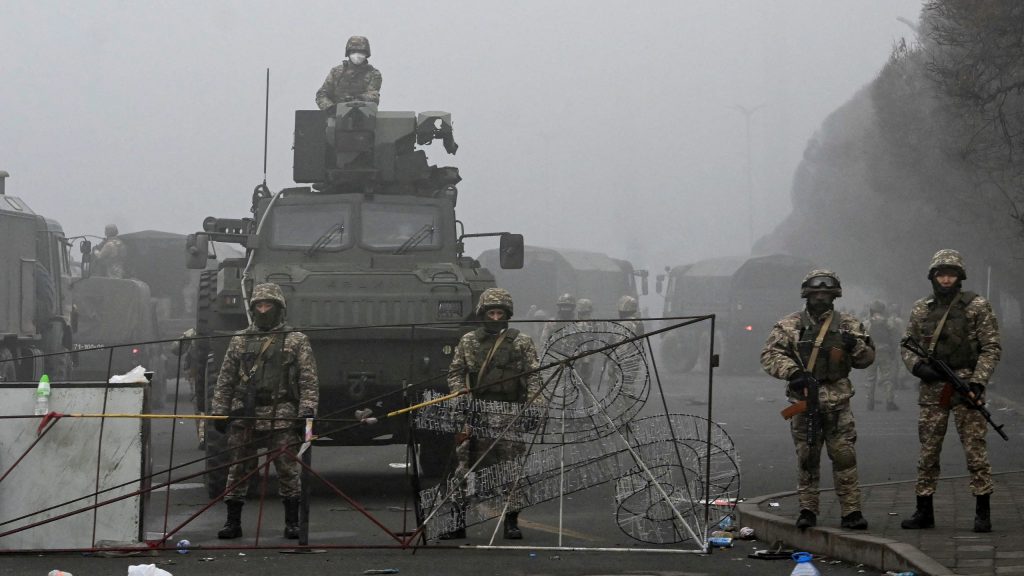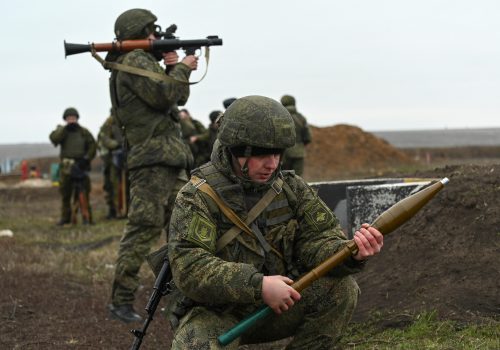This post was updated on January 6.
Thirty years ago, the Soviet Union collapsed in a largely bloodless way. But events in recent years have proved that bloodlessness to be only temporary. Russia’s war against Ukraine—with fourteen thousand Ukrainian fatalities thus far (and more in the offing if Moscow sends an invasion force of one hundred thousand into the country)—is the major proof. Its brief 2008 conflict in Georgia, meanwhile, caused hundreds of deaths.*
Sadly, the unrest in Kazakhstan may provide additional evidence. As of Thursday, dozens have been reported dead as clashes between protesters and police intensified.
The crisis in the Central Asian former Soviet republic fuses geopolitical issues across Eurasia, from Moscow’s efforts to cow the West and subjugate Ukraine to its delicate relationship with China—and the implications are enormous. It’s a happy surprise that this region has been largely stable since the end of the Tajik civil war in the late 1990s. It has proved to be a buffer for major players Russia, China, and India, as well as lesser but still important powers such as Pakistan and Iran. But the instability in Kazakhstan offers opportunities for these states to enhance their position in Central Asia, and they are seizing them.
Besieged Kazakh President Kassym-Jomart Tokayev has asked the Collective Security Treaty Organization (CSTO), the Russian-led military alliance, to help restore order. Armenian Prime Minister Nikol Pashinyan, who is the rotating head of the group, has announced it will send troops. This is significant for two reasons. First, Russian President Vladimir Putin’s goal of restoring Russian influence in the post-Soviet space is not limited to Ukraine, Georgia, and Moldova; Tokayev’s invitation gives Moscow the chance to do just that in Central Asia’s richest country. Second, Tokayev had another option: the Shanghai Cooperation Organization (SCO), led by China but which also includes Russia. Despite growing cooperation between Moscow and Beijing in opposing US policies globally, the two are competitors in Central Asia.
Putin infamously said at Lake Seliger in 2014 that Kazakhstan was an artificial country created by its first president, Nursultan Nazarbayev, and its population understands the importance of close relations with Russia. Ethnic Russians comprise 18 percent of the country’s population, and they—along with more than 60 percent of Kazakhstan’s hydrocarbon resources—are concentrated in the north, not far from the Russian border. Since Putin’s remark, Kremlin allies have called for the “return” of northern Kazakhstan to Russia. Meanwhile, China has its own territorial pretensions on the country.
It’s safe to assume that the CSTO decision was in fact Putin’s decision. This means that he considered it more important to strengthen Moscow’s position in Kazakhstan than to accommodate China. While this is not likely to have an immediate, visible impact on Russia’s relations with China, it’s a message to Beijing that there are limits to Moscow’s acceptance of junior-partner status in their bilateral relationship. Over time, this will shape the relationship.
And this brings us to Moscow’s current buildup of approximately one hundred thousand troops on and near Ukraine’s border, as well as its efforts to squeeze concessions out of the United States, NATO, the European Union, and Ukraine with the threat of a major conventional offensive. He is threatening this invasion because his nearly eight-year hybrid war against Ukraine has failed to achieve its objective: to prevent the country’s westward drift. But Putin’s current focus on Ukraine is not meant to come at the expense of his other geopolitical objectives in Eurasia. To the extent possible, he would like to restore Kremlin influence across the territory of the former Soviet Union. In some places—Crimea, and perhaps northern Kazakhstan—that means Moscow seizing and annexing territory. In other places, it means ensuring national-security and economic policies consistent with Kremlin interests.
The unrest in Kazakhstan poses a question for Putin: Should he continue his intimidation campaign on his western flank, or should he address the dangers to his south? Or can he do both? At the moment, Putin is trying to have his cake and eat it too. Maybe the CSTO can impose order and restore Tokayev’s government without significantly reducing Russian forces on Ukraine’s border. That is certainly the Kremlin preference, because its long military buildup and threats to Ukraine have produced talks with the United States, NATO, and the Organization for Security and Cooperation in Europe that might achieve some concessions on issues such as limiting NATO enlargement and the Alliance’s activities in Eastern Europe, or the Minsk talks on ending Moscow’s war in the Donbas region of Ukraine. He would prefer not to reduce the pressure.
Yet if the initial CSTO deployment fails, Putin may face a dilemma. Moscow’s pre-buildup situation in Ukraine was a stalemate; in Kazakhstan, Moscow’s position in Central Asia would deteriorate if a popular revolt produces a reform-minded government, or if Tokayev calls on China and the SCO for help to stay in power. The question then becomes: Would Putin pull troops from Ukraine’s border to deal with disorder in Kazakhstan and enhance Russia’s standing in Central Asia? Doing so certainly entails less risk than launching a major conventional military offensive in Ukraine. Putin could easily explain standing down temporarily in the west to secure a new trophy in the south. And that still would not preclude a third buildup of Russian forces on Ukraine’s border.
The stakes for Putin are large in both Kazakhstan and Ukraine—but it may prove difficult for the arch opportunist to successfully attend to both at the same time.
John Herbst is the senior director of the Atlantic Council’s Eurasia Center and former US ambassador to Ukraine and Uzbekistan.
An earlier version of this article incorrectly stated the number of deaths in the 2008 Russian war in Georgia. The war caused hundreds of deaths.
Further reading
Thu, Dec 23, 2021
Is Ukraine’s reformed military ready to repel a new Russian invasion?
UkraineAlert By
Ukraine's military has undergone a major transformation since the outbreak of hostilities with Russia in 2014 but the changes that have taken place are still not fully assessed or understood.
Thu, Dec 30, 2021
How to deal with the Kremlin-created crisis in Europe
UkraineAlert By
The Kremlin appears to be setting the stage for a major conventional assault on Ukraine. Twenty-five distinguished experts and former senior officials urge the Biden administration to take decisive action.
Wed, Jan 5, 2022
Kazakhstan is in chaos. Here’s why the West should be watching.
New Atlanticist By
Atlantic Council experts break down what's at stake for Russia, energy supplies, and the future of the strategically located Central Asian nation.
Image: Troops guard the main square in Almaty, Kazakhstan, where hundreds of people protested against the government, January 6, 2022. Photo by Mariya Gordeyeva/File Photo/REUTERS



